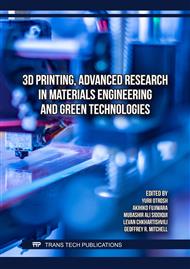[1]
K. Srinivasu, M.L.N. Krishna Sai, V.S. Kumar, A review on use of metakaolin in cement mortar and concrete, Int. J. Innov. Res. Sci. Eng. Technol. 3 (7) (2014) 14697-14701.
Google Scholar
[2]
M.A. Akinpelu, A.Sh.M. Salman, Y.A. Jimoh, I.T. Yahaya, H.M. Salami, Impact of treatment temperature of metakaolin on strength and sulfate resistance of concrete, Res. Eng. Struct. Mater. 10 (3) (2024) 1261-1279.
Google Scholar
[3]
J.A. Kostuch, V. Walters, T.R. Jones, High performance concretes incorporating metakaolin: A review, Concrete 2 (1993) 1799-1811.
Google Scholar
[4]
A. Dubey, N. Banthia, Influence of high reactivity metakaolin and silica fume on the flexural toughness of high-performance steel fiber-reinforced concrete, American Concr. Inst. Mater. J. 95 (3) (1998) 284-292.
DOI: 10.14359/372
Google Scholar
[5]
R. Siddique, J. Klaus, Influence of metakaolin on the properties of mortar and concrete: A review, Appl. Clay Sci. 43 (3/4) (2009) 392-400.
DOI: 10.1016/j.clay.2008.11.007
Google Scholar
[6]
S. Boonphan, S. Prachakiew, A. Klinbumrung, Crystallization and exfoliation of metakaolin under molten salt treatment, Ceramics – Silikaty 68 (1) (2024) 7-13.
DOI: 10.13168/cs.2023.0048
Google Scholar
[7]
L.I. Dvorkin, N.V. Lushnikova, R.F. Runova, V.V. Trayan, Metakaolin in Building Mortars and Concretes, KNUBiA, Kyiv, 2007.
Google Scholar
[8]
A.A. Myasnikova, Effect of metakaolin on the phase formation and structure of cement stone, Architect. Urban Constr. 32 (2022) 41-48.
Google Scholar
[9]
M.A.H. Kamal, N. Salleh, N.A.A. Hamid, Z. Jamellodin, N. Ali, S.R. Abdullah, S.H. Adnan, Review on metakaolin impact on the workability and compressive strength of concrete, IoP Conf. Ser. Earth Environ. Sci. 1347 (2024) 012085 (1-10).
DOI: 10.1088/1755-1315/1347/1/012085
Google Scholar
[10]
D.L. Pillay, O.B. Olalusi, P.O. Awoyer, C. Rondon, A.M. Echeverria, J.T. Kolawole, A review of the engineering properties of metakaolin based concrete: Towards combatting chloride attack in coastal/marine structures, Adv. Civil Eng. 2020 (2020) 8880974 (1-13).
DOI: 10.1155/2020/8880974
Google Scholar
[11]
A. Palomo, M.T. Blanco–Varela, M.L. Granizo, F. Puertas, T. Vazquez, M.W. Grutzeck, Chemical stability of cementitious materials based on metakaolin, Cem. Concr. Res. 29 (7) (1999) 997-1004.
DOI: 10.1016/s0008-8846(99)00074-5
Google Scholar
[12]
M. Rashad, Metakaolin as cementitious material: History, scours, production and composition – A comprehensive overview, Constr. Build. Mater. 41 (2013) 303-318.
DOI: 10.1016/j.conbuildmat.2012.12.001
Google Scholar
[13]
G.L. Thankam, N.T. Renganathan, Ideal supplementary cementing material – Metakaolin: A review, Int. Rev. Appl. Sci. Eng. 11 (1) (2020) 58-65.
DOI: 10.1556/1848.2020.00008
Google Scholar
[14]
Y. Wang, H. Fang, P. Chen, Ch. Pei, J. Li, X. Shen, Bio-functionalization of metakaolin for better performance of metakaolin mortars, Appl. Clay Sci. 245 (2023) 107161 (1-5).
DOI: 10.1016/j.clay.2023.107161
Google Scholar
[15]
M.N. Al-Hashem, M.N. Amin, A. Ajwad, M. Afzal, K. Khan, M.I. Faraz, M.Gh. Qadir, H. Khan, Mechanical and durability evaluation of metakaolin as cement replacement material in concrete, Materials 15 (22) (2022) 7868 (1-18).
DOI: 10.3390/ma15227868
Google Scholar
[16]
J. Davidovits, Geopolymers: Ceramic-like inorganic polymers, J. Ceram. Sci. Technol. 8 (3) (2017) 335-350.
Google Scholar
[17]
A. Palomo, M.W. Grutzeck, M.T. Blanco, Alkali-activated fly ash cement for future, Cem. Concr. Res. 29 (8) (1999) 1323-1329.
DOI: 10.1016/s0008-8846(98)00243-9
Google Scholar
[18]
A. Palomo, P. Krivenko, I. Garcia–Lodeiro, E. Kavalerova, O. Maltseva, A. Fernandez–Jimenez, A review on alkaline activation: New analytical perspectives, Materiales de Construccion 64 (315) (2014) e022 (1-24).
DOI: 10.3989/mc.2014.00314
Google Scholar
[19]
P. Duxon, A. Fernandes–Jimenes, J.L. Provis, G.C. Lukey, A. Palomo, J.S.J. van Deventer, Geopolymer technology: The current state of the art, J. Mater. Sci. 42 (9) (2007) 2917-2933.
DOI: 10.1007/s10853-006-0637-z
Google Scholar
[20]
E. Shapakidze, M. Avaliani, M. Nadirashvili, V. Maisuradze, I. Gejadze, T. Petriashvili, Obtaining and studying the properties of new geopolymer binders based on calcined clay rocks and local industrial waste, Eur. Chem. Bull. 11 (6) (2022) 67-73.
DOI: 10.52340/ns.2020.06
Google Scholar
[21]
E. Shapakidze, M. Avaliani, M. Nadirashvili, V. Maisuradze, I. Gejadze, T. Petriashvili, Synthesis and study of properties of geopolymer materials developed using local natural raw materials and industrial waste, Chem. Chem. Technol. 17 (4) (2023) 711-718.
DOI: 10.52340/ns.2022.14
Google Scholar
[22]
E. Shapakidze, M. Nadirashvili, V. Maisuradze, I. Gejadze, M. Avaliani, G. Todradze, Elaboration of optimal mode for heat treatment of shales for obtaining metakaolin, Eur. Chem. Bull. 8 (1) (2019) 31-33.
DOI: 10.17628/ecb.2019.8.31-33
Google Scholar
[23]
E. Shapakidze, I. Gejadze, M. Nadirashvili, V. Maisuradze, T. Petriashvili, A. Skhvitaridze, Using clay rocks of Georgia to obtain high-active pozzolanic additives to Portland cement, Int. J. Appl. Eng. Res. 14 (18) (2019) 3689-3695.
DOI: 10.52340/ns.2020.06
Google Scholar


